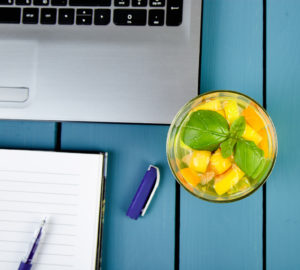by Michelle Sutton-Kerchner
The arrival of warm weather brings ongoing reminders to stay hydrated, including a parched palate. Summer’s heat definitely requires plenty of extra fluids. However, regardless of the season, fitness gurus know hydration is essential …
The hot summer sun provides the biggest nudge to refill your water bottle. Thirst quickly becomes apparent when outdoors, whether active or reclining on a sunny patio. Usually, you know when to hydrate through simple physical cues.
During exercise, especially while indoors, the body’s thirst indicator can be trickier to decipher. When focused on reps and their result-producing sweat you may neglect thirst—or be unaware of it entirely. An air-conditioned workout is sometimes comfortable enough to miss thirst signals. Be prepared with a hydration plan. (Worry not. It is more informal than it sounds.)
Fitness Hydration
Suggestions vary on adequate daily fluid intake. Beyond beverage consumption, hydration comes in the form of fruits, veggies, and other foods. Activity level and environment are also factors. Therefore, a hard rule of daily requirements may not be accurate for every individual and situation.
Monitor the precision of guidelines according to the most basic indicator of all: urine color. Pale yellow should be your health goal, right up there with increasing stamina and improving your kettlebell swing.
Workout Guidelines

Before: Drink about two cups of water two hours prior to your workout.
During: Sip four to six ounces of water every 20 minutes, more frequently during high-intensity workouts.
After: Replenish with more water, drinking until quenched, cooled and beyond. Some experts recommend weighing yourself before and after a workout. They advise drinking 20 ounces of fluid for every pound of water-weight lost.
Your Drink of Choice
In most cases, water is the best hydration option. For workouts that exceed an hour, or involve maximum intensity, consider sports drinks to help replenish lost electrolytes. Look for ones that contain about 14 grams of carbs, 28 mg of potassium, and 100 mg of sodium per eight-ounce serving. Avoid carbonated waters. They can irritate your stomach while exercising.
Flavored water is a fun way to perk up your workout. Make your own with fresh fruit. Some water bottles even include a fruit-infuser section. Consider adding lemon, cucumber slices, strawberries, and fresh mint. You’ll also gain some extra vitamins and minerals with these fusions.
Water Everywhere but Not a Drop to Drink

Dehydration is often associated with strenuous workouts and time spent in hot weather. This explains the surprised reaction common when time spent inappropriately in the spa pool, steam room, and sauna results in dehydration. After all, you’re submerged in moisture and relaxing! Follow these rules to ensure a healthy, refreshing experience.
 Avoid use after a demanding workout or extended cardio fitness session.
Avoid use after a demanding workout or extended cardio fitness session.- Go for a soak when well-hydrated. Bring a water bottle with you for continuous fluid intake. You may not recognize thirst, especially when submerged in water.
- Follow time recommendations. Excess time in these heated environments can strain your heart.
Indicators

Monitor your hydration as part of a healthy lifestyle. Aim to drink about eight to eleven cups of water daily. Start your day by drinking a full glass upon waking. Keep it bedside, to be ready during the night as well.
Dehydration can occur slowly. Look for dry mouth, fatigue, and headache. Often, these are first indicators. Respond with a full glass of water rather than sipping. This provides faster relief in these instances. Then, keep water with you as a habit. You will find it easy to mindless sip away your requirements throughout the day.
Sources
“4 Simple Ways to Stay Hydrated This Summer,” by Johannah Sakimura at everydayhealth.com.
webmd.com
 Fitness & Wellness News Your Source for Fitness News, Wellness News, Health News, and Nutrition News!
Fitness & Wellness News Your Source for Fitness News, Wellness News, Health News, and Nutrition News!




